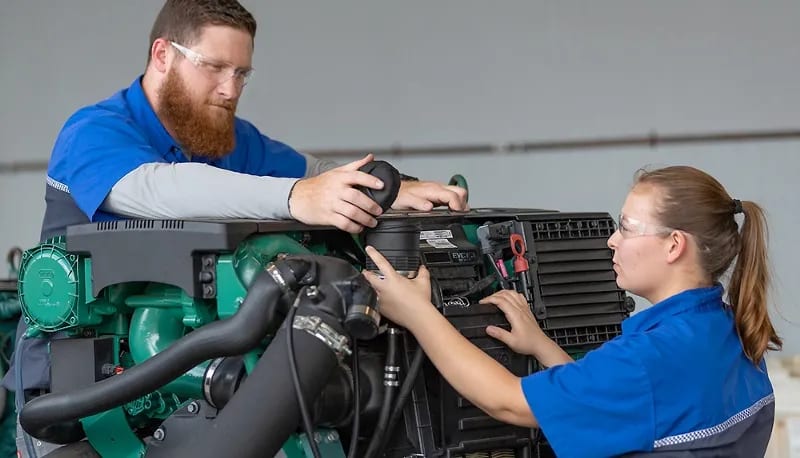Common Boat Engine Problems
Marine technicians encounter several common boat repairs throughout their career. Learn what they are here!
If you own a boat or just love the water, one of the most important parts of any boat is the engine. It’s an important part to consider when thinking about how the boat will be used.
There are several types of boat engines and propulsion systems available. This article highlights the differences and key attributes that set them apart.
Key points
Boat engines are complex machines. They convert fuel into propulsion, which pushes the boat or vessel forward to navigate through water. Its combustion engine is what burns fuel to create that power. This power is then transferred through a transmission system to either a propeller or a jet drive, which ultimately propels the boat.
There are three primary types of boat engines: outboard, inboard and jet engines. Each type of engine has a power source, typically gasoline or diesel, which is ignited within the engine's cylinders.
A boat engine is comprised of several key components, each playing a crucial role in converting fuel into mechanical energy to propel the vessel:
When choosing a boat and engine, it’s good to know the basic types of engine and propulsion systems to help with your decision. A dealer or trained technician should be able to answer specific technical questions, but a foundational knowledge of what your options are can make a big difference.
There are several marine engine and propulsion systems out there, but the four main types are outboard, inboard, sterndrive and jet drive.
An outboard engine, also known as an outboard motor, is a unit containing the engine, gearbox and propeller. This part — you guessed it — is mounted to the back of the boat and hangs outside the hull. An outboard engine is used to power and steer the boat.
This means the entire engine needs to be able to move side to side while steering, as well as up and down for trimming and trailering. Smaller boats allow the engine to be steered manually using a hand tiller, while larger vessels are equipped with steering wheels.
The engine propeller and gear case are underwater during use, giving the boat the ability to plane quickly and be very agile while turning and docking. Outboards are versatile and commonly used for fishing, watersports and pleasure boating.
Read: 2-STROKE VS. 4-STROKE OUTBOARD MOTORS
Inboard engines are mounted inside the hull at midships (middle of the boat). The propeller is turned by the propeller shaft, which runs through the bottom of the boat and exits near the transom (back of the boat). Steering is controlled by a rudder that directs the flow of water as it passes and allows the operator to maneuver the boat with a steering wheel.
Inboard engines are often the choice for boats that are going to be used with watersports since they create a predictable wave that wakeboarders love. They are also used on vessels where more horsepower and torque are needed.

Also known as inboard/outboards, sterndrive engines have the features and benefits of both outboard and inboard engines. Sterndrives utilize an engine that is mounted on the inside of the hull for power. They’re attached through the transom to a drive unit that resembles the lower gearcase portion of an outboard. Like outboard engines, this drive unit is used to steer the boat.
Sterndrives turn like outboard engines to direct the propeller and turn the boat. Sterndrives can be beneficial for applications where more horsepower and torque are needed, as well as agility while maneuvering and docking. Sterndrives are very common in pleasure boats.
Jet drive engines are primarily associated for use with personal watercraft, but many boats also feature jet drive propulsion systems. These systems utilize water to both propel and steer the boat.
To make this happen, an engine drives an impeller, which is similar to a propeller, but sharper. The impeller, which is located beneath the boat, forces water through a small nozzle out the back, which generates thrust. The boat is steered when the direction of the stream of water is changed.
Jet drive systems provide high performance and work best in shallow water. Also, there are no exposed propeller blades.
Two of the biggest factors to consider when choosing an engine for your boat are size and fuel delivery systems:
Before choosing an engine, the weight and size of your boat should be considered. The weight estimate should include all gear, passengers and fuel you plan to have on board. Matching your engine as close as possible to the maximum horsepower your boat is rated for is a good rule of thumb.
There are three main types of fuel delivery systems on the market for gasoline engines: direct fuel injection, electronic fuel injection and carbureted fuel systems.
Direct fuel-injection engines offer benefits that include low emissions and good fuel economy. Electronic fuel-injection systems offer uniform air and fuel distribution and high throttle response and power. Carbureted fuel systems typically offer the lowest initial cost, though they might have higher emissions and decreased fuel economy compared with the other two delivery systems.
If you love being around boats and being on the water, a career as a marine technician could be something to consider. Universal Technical Institute (UTI) offers a 51-week Marine Technician Specialist training program that could give you the training and education you need for the industry.1
Courses cover a range of topics to give you the foundational knowledge employers are looking for, including an overview of a range of boat engines. Students are taught the skills necessary to diagnose and service these major parts.
Pursue a job in a field you’re passionate about. UTI can help get you there. Request more information today!
Universal Technical Institute of Illinois, Inc. is approved by the Division of Private Business and Vocational Schools of the Illinois Board of Higher Education.